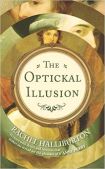The Optickal Illusion: A very eighteenth-century scandal by Rachel Halliburton
Rachel Halliburton's debut novel opens in London in January 1797. Benjamin West, President of the Royal Academy, is reflecting on the past year's scandal involving the Provises, father and daughter, and worries that he handled everything poorly. From the start the book's figurative language is appropriately full of colour and painterly techniques: 'He had intended to deal with them honourably, but now everyone in London was saying he had not. It was as if somebody had dropped a small amount of ivory black paint into yellow orpiment on a palette – the more he prodded and stirred the memory, the murkier it became.'
| The Optickal Illusion: A very eighteenth-century scandal by Rachel Halliburton | |
|
| |
| Category: Historical Fiction | |
| Reviewer: Rebecca Foster | |
| Summary: Halliburton's debut novel is inspired by a real-life scandal that shook the Royal Academy of Arts in the 1790s while American-born Benjamin West was its president. The descriptive language and various cameos from other historical figures are highlights. | |
| Buy? Maybe | Borrow? Yes |
| Pages: 352 | Date: February 2018 |
| Publisher: Gerald Duckworth & Co Ltd | |
| External links: Author's website | |
| ISBN: 9780715651971 | |
|
| |
The rest of the book unfolds in flashbacks. From his upbringing in backwoods Pennsylvania, West rises to the top of the art world by learning from Italian masters in the 1760s. By 1795, when he meets the Provises, his star is fading. Mr Provis is a verger in the Chapel Royal of St James's Palace, and his seventeen-year-old daughter, Ann Jemima, is an aspiring artist herself. The Provises have in their possession a manuscript revealing how to paint like Titian – known as 'the Venetian secret'. They are willing to give this over to West and the rest of the newly formed Royal Academy for the princely sum of £400. West has his own theory of colours, based on the rainbow emitted from a prism: red, orange and yellow are to him the primary colours on which there should be cast the most light; while green, blue and violet should be consigned to less significant regions of a painting. Perhaps he can pass off Titian's technique of layering transparent glazes over colours as his own and revive his career?
Those who are familiar with the eighteenth-century art world will be delighted to see how Halliburton weaves in figures like Joshua Reynolds, Henry Fuseli, Joseph Johnson and John Opie. We also get glimpses of wider contemporary history in France and Ireland. I especially liked Mary Wollstonecraft's walk-on role in Chapter 16, and the later cameo from Thomas Paine and William Wordsworth. It's clear that a huge amount of research has gone into crafting believable scenes in the America, England and Italy of the time. The descriptive language is rich with colours and patterns, creating what are basically miniature landscapes:
'From the window so many fragmented impressions. London's dirt – tyrannical, colonising every detail of life – gradually yielded to the sodden blacks and browns of the January countryside. As the coach gathered pace, [Josiah] Darton became hypnotised by the long stretches of fields and hedges interspersed by sporadic outbreaks of small houses and churches, islands of snow on the shivering grass, and chimneys fluting smoke into a white sky.'
There are a lot of names and time jumps to keep up with, and the narration moves inconsistently between past and present tense. I also found some of the metaphors a bit overwritten: 'Her eyes as agitated as lightning-lit seas', 'Hobnailed boots of self-reproach stamp through her mind', and 'It was as if the coffee were a dark bitter oxygen for the nervous spark of ideas'. However, this is overall an absorbing story with lively characters and an unconventional female lead.
Further reading suggestion: The writing style is reminiscent of the historical pastiche in Resolution by A N Wilson. If you enjoy historical fiction with an eighteenth-century setting, you may also want to read the delightful Golden Hill by Francis Spufford. We can also recommend In Search of Mary: The Mother of all Journeys by Bee Rowlatt.
Please share on: ![]() Facebook,
Facebook, ![]() Twitter and
Twitter and
![]() Instagram
Instagram
![]() You can read more book reviews or buy The Optickal Illusion: A very eighteenth-century scandal by Rachel Halliburton at Amazon.co.uk Amazon currently charges £2.99 for standard delivery for orders under £20, over which delivery is free.
You can read more book reviews or buy The Optickal Illusion: A very eighteenth-century scandal by Rachel Halliburton at Amazon.co.uk Amazon currently charges £2.99 for standard delivery for orders under £20, over which delivery is free.
![]() You can read more book reviews or buy The Optickal Illusion: A very eighteenth-century scandal by Rachel Halliburton at Amazon.com.
You can read more book reviews or buy The Optickal Illusion: A very eighteenth-century scandal by Rachel Halliburton at Amazon.com.
Comments
Like to comment on this review?
Just send us an email and we'll put the best up on the site.

